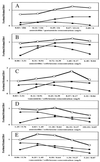Fractional maximal effect method for in vitro synergy between amoxicillin and ceftriaxone and between vancomycin and ceftriaxone against Enterococcus faecalis and penicillin-resistant Streptococcus pneumoniae
- PMID: 11709304
- PMCID: PMC90833
- DOI: 10.1128/AAC.45.12.3328-3333.2001
Fractional maximal effect method for in vitro synergy between amoxicillin and ceftriaxone and between vancomycin and ceftriaxone against Enterococcus faecalis and penicillin-resistant Streptococcus pneumoniae
Abstract
In the present study we assessed the use of a new in vitro testing method and graphical representation of the results to investigate the potential effectiveness of combinations of amoxicillin (AMZ) plus ceftriaxone (CRO) and of CRO plus vancomycin (VAN) against strains of Streptococcus pneumoniae highly resistant to penicillin and cephalosporins (PRP strains). We used the fractional maximal effect (FME) method of time-kill curves to calculate adequate concentrations of the drugs to be tested rather than relying on arbitrary choices. The concentrations obtained, each of which corresponded to a fraction of the maximal effect, were tested alone and in combination with the bacterial strains in a broth medium. Synergy was defined as a ratio of observed effect/theoretical effect, called FME, of greater than 1, additivity was defined as an FME equal to 1, and antagonism was defined as an observed effect lower than the best effect of one of the antibiotics used alone. The area between antagonism and additivity is the indifference zone. The well-known synergy between amoxicillin and gentamicin against a reference strain of Enterococcus faecalis was confirmed, with a best FME equal to 1.07. Two strains of PRP, strains PRP-1 and PRP-2, were studied. The MICs for PRP-1 and PRP-2 were as follows: penicillin, 4 and 16 microg/ml, respectively; AMZ, 2 and 8 microg/ml, respectively, CRO, 1 and 4 microg/ml, respectively; and VAN, 0.5 and 0.25 microg/ml, respectively. For PRP-1 the best FME for the combination AMZ-CRO was 1.22 with drug concentrations of 1.68 mg/liter for AMZ and 0.17 mg/liter for CRO; the best FME for the combination VAN-CRO was 1.75 with VAN at 0.57 mg/liter and CRO at 0.17 mg/liter. For PRP-2 the best FME obtained for the combination AMZ-CRO was 1.05 with drug concentrations of 11.28 mg/liter for AMZ and 0.64 mg/liter for CRO; the best FME obtained for the combination VAN-CRO was 1.35 with VAN at 0.25 mg/liter and CRO at 1.49 mg/liter. These results demonstrated the synergy of both combinations, AMZ-CRO and VAN-CRO, against PRP strains at drug concentrations achievable in humans. Consequently, either of the combinations can be proposed for use for the treatment of PRP infections.
Figures


Similar articles
-
Time-kill evaluation of antimicrobial regimens against clinical isolates of penicillin-resistant Streptococcus pneumoniae.J Chemother. 2001 Oct;13(5):535-40. doi: 10.1179/joc.2001.13.5.535. J Chemother. 2001. PMID: 11760218
-
In vitro susceptibility of Streptococcus pneumoniae strains to nine beta-lactam antibiotics and the killing kinetics of cephalosporins alone and in combination with vancomycin or gentamicin.Microb Drug Resist. 1996 Fall;2(3):361-9. doi: 10.1089/mdr.1996.2.361. Microb Drug Resist. 1996. PMID: 9158796
-
Comparison of ceftriaxone versus ceftaroline in combination with ampicillin or penicillin against Enterococcus faecalis.Microbiol Spectr. 2025 Jun 3;13(6):e0271824. doi: 10.1128/spectrum.02718-24. Epub 2025 May 15. Microbiol Spectr. 2025. PMID: 40372042 Free PMC article.
-
[Antibiotic resistance: an always present problem].Recenti Prog Med. 1999 Oct;90(10):505-9. Recenti Prog Med. 1999. PMID: 10592734 Review. Italian. No abstract available.
-
Listeria monocytogenes endocarditis: case report, review of the literature, and laboratory evaluation of potential novel antibiotic synergies.Int J Antimicrob Agents. 2018 Mar;51(3):468-478. doi: 10.1016/j.ijantimicag.2017.12.032. Epub 2018 Jan 11. Int J Antimicrob Agents. 2018. PMID: 29337066 Free PMC article. Review.
Cited by
-
Ampicillin in Combination with Ceftaroline, Cefepime, or Ceftriaxone Demonstrates Equivalent Activities in a High-Inoculum Enterococcus faecalis Infection Model.Antimicrob Agents Chemother. 2016 Apr 22;60(5):3178-82. doi: 10.1128/AAC.03126-15. Print 2016 May. Antimicrob Agents Chemother. 2016. PMID: 26926624 Free PMC article.
-
Intracellular activity of antibiotics in a model of human THP-1 macrophages infected by a Staphylococcus aureus small-colony variant strain isolated from a cystic fibrosis patient: study of antibiotic combinations.Antimicrob Agents Chemother. 2009 Apr;53(4):1443-9. doi: 10.1128/AAC.01146-08. Epub 2009 Feb 2. Antimicrob Agents Chemother. 2009. PMID: 19188397 Free PMC article.
-
HAMLET, a protein complex from human milk has bactericidal activity and enhances the activity of antibiotics against pathogenic Streptococci.Antimicrob Agents Chemother. 2019 Sep 9;63(12):e01193-19. doi: 10.1128/AAC.01193-19. Epub 2019 Oct 7. Antimicrob Agents Chemother. 2019. PMID: 31591115 Free PMC article.
-
In vitro Antimicrobial Activity of Ampicillin-Ceftriaxone and Ampicillin-Ertapenem Combinations Against Clinical Isolates of Enterococcus faecalis with High Levels of Aminoglycoside Resistance.Open Microbiol J. 2008;2:79-84. doi: 10.2174/1874285800802010079. Epub 2008 Jun 9. Open Microbiol J. 2008. PMID: 19088915 Free PMC article.
-
Pharmacokinetics and relative bioavailability of an oral amoxicillin-apramycin combination in pigs.PLoS One. 2017 Apr 20;12(4):e0176149. doi: 10.1371/journal.pone.0176149. eCollection 2017. PLoS One. 2017. PMID: 28426744 Free PMC article.
References
-
- Barriere S L, Ely E, Kapusnik J E, Gambertoglio J G. Analysis of a new method for assessing activity of combinations of antimicrobials: area under the bactericidal activity curve. J Antimicrob Chemother. 1985;16:49–59. - PubMed
-
- Berenbaum M C. Minor synergy and antagonism may be clinically important. J Antimicrob Chemother. 1987;19:271–273. - PubMed
-
- Blaser J. Interactions of antimicrobial combinations in vitro: the relativity of synergism. Scand J Infect Dis Suppl. 1991;74:71–79. - PubMed
-
- Bliss C I. The toxicity of poisons applied jointly. Ann Appl Biol. 1939;26:585–615.
-
- Bulletin Epidémiologique Annuel Numéro 2. Epidémiologie des maladies infectieuses en France. Situation en 1997 et tendances évolutives récentes. 1999. Réseau National de Santé Publique, Paris, France.
MeSH terms
Substances
LinkOut - more resources
Full Text Sources
Other Literature Sources
Medical
Research Materials

